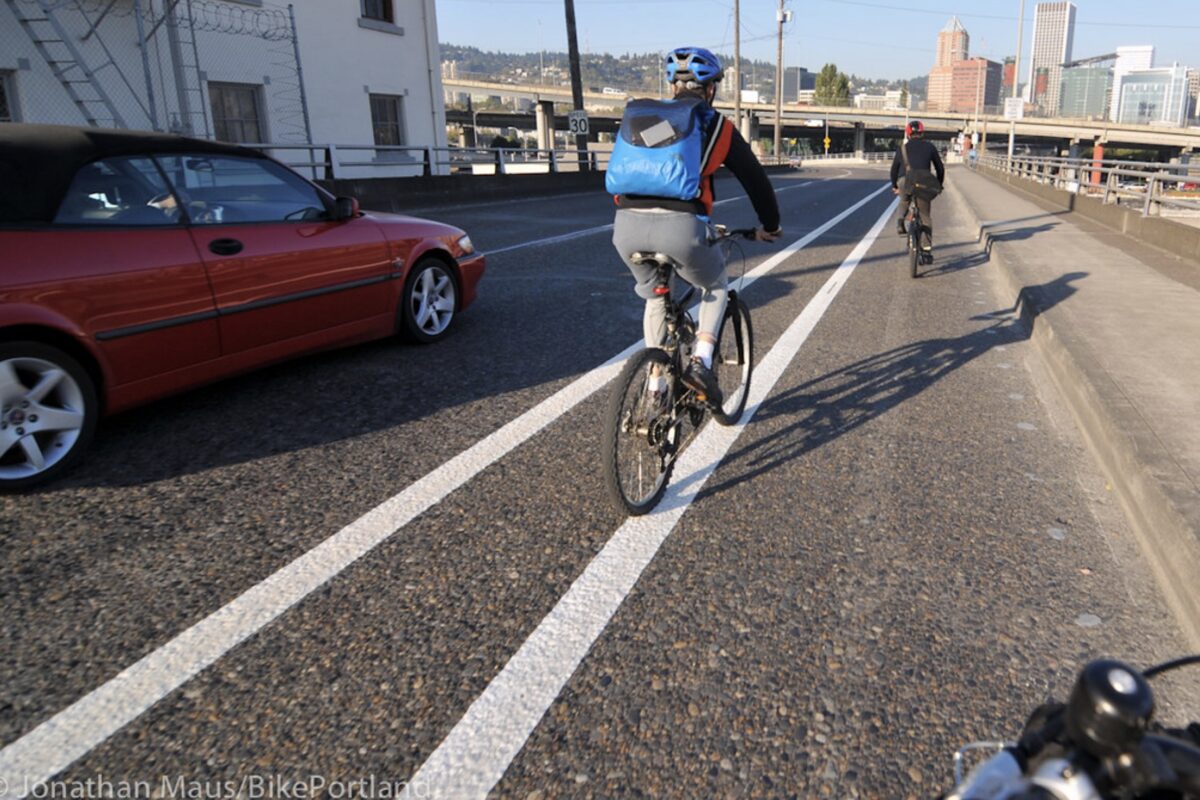
(Photo: Jonathan Maus/BikePortland)
Multnomah County transportation officials and the Portland Bureau of Transportation are working together to reduce speed limits on several Willamette River bridges. The county owns and operates five bridges on the river that are within Portland city limits and the two agencies agree that lower speed limits are necessary to reach Vision Zero safety goals and to create a more welcoming environment for non-drivers.
PBOT and the County want speed limits on all five of the their downtown bridges — the Broadway, Burnside, Hawthorne, Morrison and Sellwood — to not exceed 30 mph.
But the Oregon Department of Transportation has so far not granted them permission to do this on two key spans, the Burnside and the (westbound) Madison Street viaduct of the Hawthorne. Now Multnomah County plans to appeal ODOT’s decision at a meeting of the state’s Speed Zone Review Panel next month.
While ODOT has ceded some authority to set speed limits to local governments over the years (thanks to arm-twisting by the City of Portland), they still have final say on county bridges.
According to sources at Multnomah County, ODOT has so far recommended that the speed limits on the Burnside Bridge and SE Madison viaduct of the Hawthorne remain at 35 mph (I’m working to learn more about their rationale).
Advertisement
The Madison viaduct is about 34-feet wide and has three travel lanes: two general purpose lanes and one unprotected bike lane. The Burnside Bridge is 53-feet wide and has seven vehicle lanes and sidewalks on both sides. Bike lanes in both directions are protected by plastic wands. The speed limit on both these sections of roadway is currently 35 mph.
The speed limits were on the agenda of the Multnomah County Bicycle and Pedestrian Advisory Committee Wednesday night and members agreed to write a letter in support of the county’s appeal.
In the letter dated October 14th and signed by MCBPAC Chair Andrew Holtz, the committee says they “strongly support” a reduction of the speed limits from 35 to 30 mph. “The speed limit reduction is in coordination with the PBOT Vision Zero program, which has a goal to reduce all speeds in the Central City area, including the County-owned bridges,” the letter reads.
“Both the SE Madison viaduct and the Burnside Bridge have unprotected bicycle lanes marked only by flexible delineator separators,” the letter continues. “It is important for the safety of bicycle lane users to reduce the speed differential with motor vehicle traffic. Both areas, particularly the west end of the Burnside Bridge, host vulnerable populations. As bridge operator logs document, conflicts between pedestrians and motor vehicle drivers are common occurrences here. The people who use these areas deserve to have slower, safer motor vehicle traffic.”
Beyond safety, the letter says speed limits should be consistent on all downtown bridges.
Stay tuned for more details and updates as this issue develops.
— Jonathan Maus: (503) 706-8804, @jonathan_maus on Twitter and jonathan@bikeportland.org
— Get our headlines delivered to your inbox.
— Support this independent community media outlet with a one-time contribution or monthly subscription.

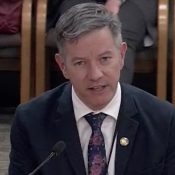
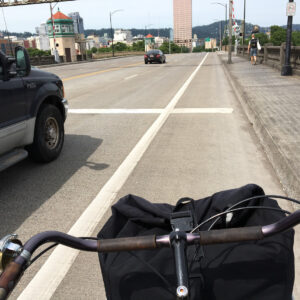
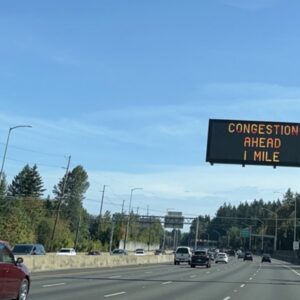
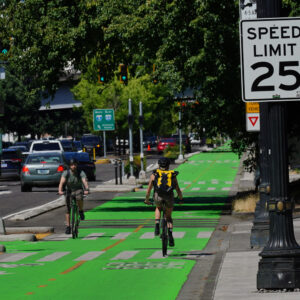
Thanks for reading.
BikePortland has served this community with independent community journalism since 2005. We rely on subscriptions from readers like you to survive. Your financial support is vital in keeping this valuable resource alive and well.
Please subscribe today to strengthen and expand our work.
Lowering speed limits without enforcement does nothing. Why do they keep
doing this?
Yex,
Yes, in some ways lower speed limits don’t have the intended impact if there aren’t good enforcement mechanisms in place… But lowering the limits is an absolutely crucial step to take. How do you think enforcement works if speed limits are set too high? Do you realize that cameras and cops don’t even care about speeding until people are like 9-11 mph over the limit? Thus, lowering the limit, makes it easier to convict on speed citations. Also, if you are hit while biking and take a case to court, the speed limit matters a lot when the judge is hearing the defense’s side of the case and when you are trying to squeeze money out of an insurance company. And I think lower speed limits are also crucial in the changing the culture around speeding.
So please think before repeating this “Lowering speed limits without enforcement does nothing” stuff. thanks.
I actually commented after reading the article but before reading the comments. It looks like Yex feels the same way.
About as well as it does when they are lower. Who cares what the speed limit is when everyone knows you can drive however fast you want in this city?
It sounds like that’s the actual, solvable problem.
LMAO motorists don’t care. It just feeds into their persecution complex that the city wants it to be hard as possible to drive. If anything, lowering speed limits makes drivers just more angry and aggressive.
Bleh, so condescending. It does do nothing. It’s great you can think of a couple fake scenarios where fake helps but we are talking about the real streets.
It only takes one mv operator driving the limit, or below, to completely change the character of traffic on a bridge. ‘Herd immunity’ to traffic car-nage kicks in somewhere around 20% in this case.
Not when there are two lanes. I go the speed limit on the Burnside and get passed by people going 60.
“[L]owering speed limits makes drivers just more angry and aggressive.” So drivers on residential streets are more angry and aggressive than they are when on freeways? Data please.
Lower posted speed is a necessary part of getting the engineering or (worst case) enforcement (preferably automated) to achieve it.
Well, then why not pair the lowered limits with increased enforcement? We have an identity politics problem where we have chosen to not enforce laws because of a notion that this would discriminate against lawbreakers of some specific group. Of course Portland has decided to suspend enforcement of laws BEFORE they have developed what they feel in is a better way to enforce laws. Better to be woke than prevent deaths says Portland. We are left with chaos and a record number of traffic deaths.
Yex,
The problem is that too many police officers cannot be trusted to enforce laws fairly. And they have guns. That’s not “identity politics” that’s just a fact.
And I agree with you that some policy ideas have gotten put into place before solutions to the problem have… But that’s just what happens sometimes. Change is really messy. But if we decide change is necessary… which I don’t think you would dispute … then we have to be OK with some level of mess on our way to get there.
That is silliness and a path to chaos Jonathan. What do guns have to do with any of this? Mayhem is what we now have in Portland. Sure, change can be messy but Portland has perfected the process of gutting public safety programs before an alternative is in place. Instead of accepting it we need to get our elected public officials to be forward thinkers instead of knee jerk reactionists. It’s easy to destroy but not so easy to build community and public safety.
At the Multnomah County Bicycle and Pedestrian Advisory Committee meeting, we talked about the fact that reducing speed limits does not by itself reduce speeds. Other things need to happen. And reducing the speed limit will help (a little bit) to make those other things happen. Granted, there is little traffic enforcement now, but as Jonathan noted, when police do ticket drivers for speeding, a lower speed limit means a lower threshold for ticketing. Also, many drivers do notice the limits… in a perverse way, I see it happening at bridge approaches, when some drivers floor it as soon as they see the 35 MPH sign. A 30 MPH limit is closer to the limit on the streets and less of an incentive to pour on the gas.
Perhaps most important is that many road designs and treatments are based on the speed limit. There are engineering options available to use in 30 MPH zones that are not approved for 35 MPH zones. So when people ask for traffic calming measures, it’s an easier sell. And changing the road environment has the biggest effect on driver behavior.
A few signs don’t dictate driver behavior, but speed limits are being lowered all over the region. That broad trend (with reinforcement from media messaging and enforcement and engineering) can drive a cultural shift down to safer speeds.
One step at a time.
With no direct highway connection to traffic on these bridges it blows my mind that ODOT would not agree to the request. Look forward to hearing the rationale when you get it.
The rational is always one of the same old choices, take your pick: “Freight traffic would be negatively impacted,” “People are going to speed anyway, lowering the speed limit won’t change behavior” (see also: infrastructure change without enforcement is pointless), “Something something money or resources.”
Lowering speed limits without enforcement is a pointless exercise. N Willamette was lowered and the only thing it accomplished was more motorist driving in the bike lanes to pass law-abiding motorists and it increased the average MPH over the speed limit motorist are going.
St. Johns bridge is the same way. They lowered the speed limit but motorists are still driving 45-50 mph.
Are those bike Lanes on the St John’s? Sharrows don’t count.
Actually I think the Willamette speed limit reduction *did* have some effect, because it is single-lane in each direction. A driver going the limit slows everybody down. Regarding using the bike lane as a passing lane, I see this behavior mostly in the context of left-turning cars. Definitely a violation, but not as egregious as passing a moving car.
I *do* wonder why they lowered the limit in two 5 mph increments. Does someone like to change out signs? It smacks of disorganization and not knowing what the hell one is doing.
Kevin, unfortunately that’s how the state law works. Speed limits can only be changed 5 mph at a time.
“…more motorist (sic) driving in the bike lanes to pass law-abiding motorists”.
If that’s true, it sounds like lowering the speed limit does lead to at least some drivers slowing down.
“…it increased the average MPH over the speed limit motorist are going.”
I believe that, but the more important statistic if I get hit is how fast they are going. Someone going 27 on a 20 mph street is still going slower than someone going 30 on a 30 mph street.
I hope the appeal wins. We can’t have more crashes like this one (on the Burnside bridge). With lower speeds so much more can go wrong with so much less harm.
https://bikeportland.org/2015/06/15/enough-enough-another-death-must-spur-real-action-144397
That was a freak accident, not a commonly repeated pattern that we can design around. I don’t have a strong opinion about the speed limits on bridges, but I do believe we should be putting our resources (financial and political) in the places they will have the most impact.
I’m also curious to know the rational for keeping the speed limit at 35 on the viaducts along the short section between Grand and Water. The photo is looking at where speed limit gets reduced to 30 already (sign is on the left), so it is very little territory to haggle over. Something on the eastbound viaduct that would be nice to change is where the right hand off ramp and the bike lane cross just before the viaduct ends. That’s always felt like a real danger zone to me.
IMO this is not a good use of advocacy resources/goodwill. The bike lanes on the Hawthorne viaduct are as separated and protected as they are ever going to be, westbound feels very safe at this point, eastbound continues to have problems because of the MLK exit ramp, but there are bigger fish to fry, who really cares if someone is speeding in the far left-hand lane? That is as far from the bike lane as a motorist can get.
Exactly this. Both of these bridges are suitable for general use and are safer than what you’ll find beyond both ends. Especially Hawthorne isn’t an issue where separation is good and even the vehicle lanes on the bridge proper aren’t bad for faster cyclists.
In contrast, predominant speeds St John’s and Ross Island are higher, there’s no shoulder, and bail options for cyclists trying to avoid a critical situation are abysmal. These bridges are sketch even for cyclists who are comfortable in heavy traffic.
Putting too much focus on stuff like this is a great way to get tuned out when raising real safety issues.
All these bridges are just straightaway drag strip stress relief valves for drivers tired of being “stuck” in traffic. Never mind there’s always a red light at the other end of the bridge, might as well floor it and feel some speed, even if the bus catches (and hopefully passes) you at the other end.
It sucks, not sure what the solution is beyond narrow lanes for drivers and protected lanes for everyone else.
It would require ODOT to abandon their prime directive, advancing through-put, for them to lower speed limits.
People keep saying posted speeds don’t influence behavior. Evidence from Portland shows that’s inaccurate.
Yes, of course, road design should change to send a clearer psychological message about speeds (schema and scripts), and automated enforcement definitely helps, or add speed reader boards, but reducing signed speed limits reduces super-speeding and speeding overall.
In person enforcement tends to be inequitable and cause all sorts of problems, besides being generally unaffordable and unsustainable.
Your link to the PSU study was good readin’. I’ve been skeptical, like many others, that lower posted speed limits would do anything at all, but the data suggest I may have been 1.7% too cynical on this. 🙂
For those who didn’t click through, there are lots of ways to cut the percentages (percentage of overall drivers, percentage change, etc.)
Decreased super-speeding (15+MPH over) by 49.6%. Decreased speeding 10-15 mph over by 33%.
So, the most dangerous stuff went down significantly upon signage change from 25 mph to 20 mph.
I agree… clearly everyone wants to harp on enforcement, and there are certainly people that will speed regardless of the limits if there is no enforcement, but the vast majority of drivers will remain within a reasonable margin of the speed limit, thus decreasing average speeds. I am one of those drivers, I always remain within 5-10MPH of the posted limit, so if it is 30, the max I would go is 40. Angry erratic speeders are the exception, not the rule, we tend to notice them and conveniently ignore the hundred other drivers following the rules. I certainly agree that a little bit of enforcement will benefit safety, but I don’t think it is a silver bullet to traffic violence, and it is certainly used as a pretext in other areas of the Portland metro to harass marginalized people.
You do realize you are self-admittedly NOT one of the “hundred other drivers following the rules”, right? Don’t drive 40 in a 30 zone unless you want to kill and maim people.
I’m very sympathetic to the argument that this is a waste of time without enforcement. I see and experience the lawlessness on the streets here every day.
I also see some long term benefits from lowering the speed limit. Hopefully one day traffic enforcement returns, and when it does, the lower speed limits will be enforced with automated cameras or other mechanism. Also, the lower speed limits allow traffic engineers to implement roadway designs that matches the designated speed. Curves no longer need higher turn radii, lane widths, and shoulders to support higher speeds. Speed limits and roadway design are a cyclical battle – regardless of enforcement.
All that said, the lack of enforcement is simply mind numbing.
I bring up the St Johns bridge. Signed for 30 mph, a limit violated by ~90% of motorists, often by as much as 15mph. This is a bridge on which motorists intimidate all other classes of users, with impunity.
Absent bridge redesign and/or photo enforcement (ideally both), these limits are close to worthless.
And without limits, enforcement is worthless. Lack of enforcement isn’t a valid argument to not lower limits.
It is — it makes a joke of the law which makes it that much harder to enforce when it is possible.
Btw, the general strategy here of trying to slow down everything everywhere will only encourage more filtering through neighborhoods.
While I’m in favor of lowering the speed limits I think many of the bridges suffer from a similar sense of freeway-ness. Roads that suddenly feel much more open than the areas around them that invite drivers to really wind up the speeds. Unfortunately there aren’t a lot of visually narrowing design elements that could be put on a bridge to dampen this effect.